How do you cut off the tip of a branch and turn it into a tree with the same DNA? That’s something that the experts said couldn’t be done for trees thousands, even hundreds of years old. Yet Archangel Ancient Tree Archive has done it. Many times over, in fact.
All of the giant sequoia and coast redwood cuttings that were harvested during this climbing expedition have already started on that journey, thanks to the skill and effort put in by Archangel staff and volunteers. Jim Clark, an Archangel volunteer, put in many hours leading that effort and fortunately for us, took many photos and video clips along the way so that we could see how it is done.
This post is a tribute to the heroic effort put in by Jim Clark, who contributed most of the following photos, captions and video clips. Thank you, Jim!
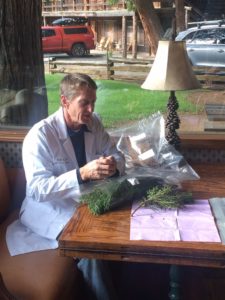
1. The material is brought off the mountain, wrapped in wet newspaper, packaged into transport bags and labeled clearly who the mother tree is.
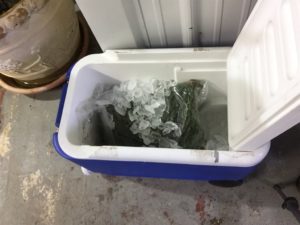
2. The collection of material was kept on ice overnight and all the way to the USDA agricultural inspection offices.

3. Jake Milarch is holding the precious cargo above his head while Jim Clark, awaiting his flight at the San Francisco airport, is holding the agricultural certificate.
4. Jim Clark flew with the cutting material overnight to Traverse City, Michigan, and from there, drove to the destination of Archangel headquarters in Copemish. He was pretty happy to arrive home with such a precious load of cuttings, as can be seen in the happy dance video below.
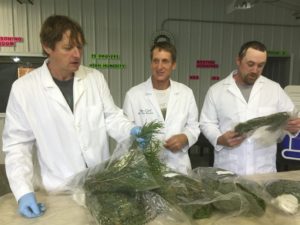
5. Tom Brodighan, Jim Clark and Chris Moore all inspected the cuttings upon arrival.
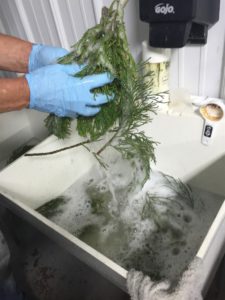
6. First the plant cuttings undergo 10 minutes of sanitizing in plant tissue-friendly disinfectant.

7. Once cleaned up and rinsed of disinfectant, the most lime-green tips with the newest, freshest growth are selected.

8. These are the result of pulling the premium stuff out of the tips. These refined cuttings will become the final explant for the grow cubes
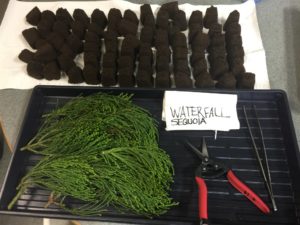
9. 72 grow cubes above, and plant material ready to be propagated.
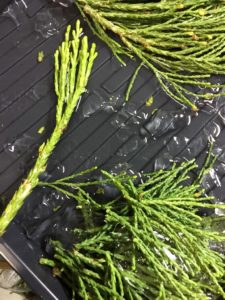
10. Close-ups of selected branch tips on ice.

11. These healthy green cuttings are what tree propagators’ dreams are made of.
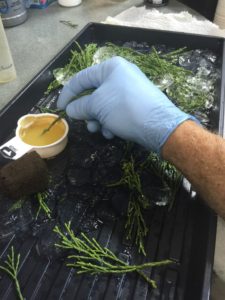
12. Next step is to select a cutting and dip it in a hormone concentration to stimulate root growth.
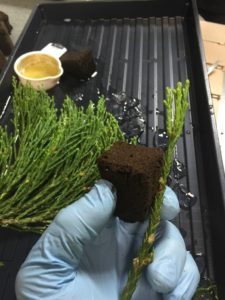
13. Then take a rooting cube . . .

14. Place the cutting into a rooting cube.
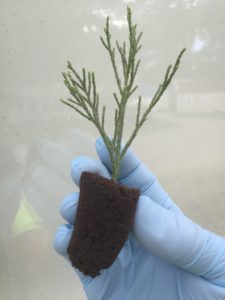
15. Voila! A sequoia cutting ready to grow into a tree.
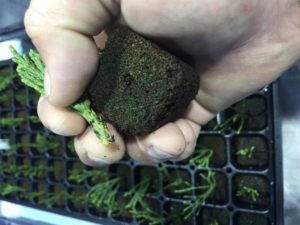
16. Above is a Stagg cutting pulled for inspection after three weeks in the rooting cube. The yellow mass right in the middle of the fingertip is called a callus, which is an undifferentiated mass of cells which gives rise to root primordia, and then full-fledged roots! WooHoo! A new tree is coming to life!
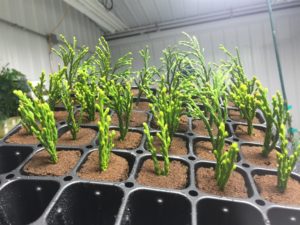
17. Repeat the process many times, and pretty soon there is a young sequoia forest sprouting.

18. Stick cuttings get done first. When the trays of cuttings are finished you should have a tidy pile of small, premium material, kept moist and chilled throughout the whole process.
19. Below is a time-lapse version of what it is like to put together a flat of 72 tiny, ancient, new cuttings.
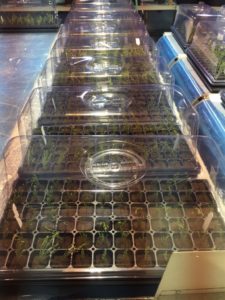
20. Over 10 flats of trees started. That’s 720 new trees!
Next, on to the tissue culture method of propagating new trees using cuttings from ancient trees. One of the differences between the rooting block approach and the tissue culture methods of propagation is the size of the plant material.
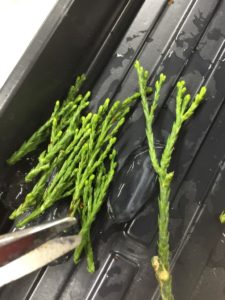
21. The plant material on the left is the proper size for tissue culture propagation, whereas the cutting on the right, about 2-1/2 “ (6.5 cm) is a good size for using in rooting blocks.
Also, the tissue culture approach requires sterile conditions. Here are the cleaning steps required when using the tissue culture approach.
Step 1 disinfect for 10 minutes in a sanitizing solution.
Step 2 immerse in an antimicrobial solution of hydrogen peroxide to oxidize the bacterial cells and dissolve the cutinous, waxy layer on the plant surface.
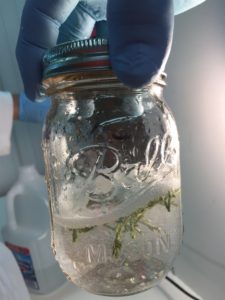
22. Step 3 immerse in a biological detergent.
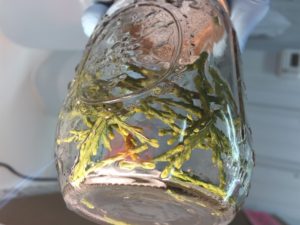
23. Step 4 rinse in previously sterilized distilled water.
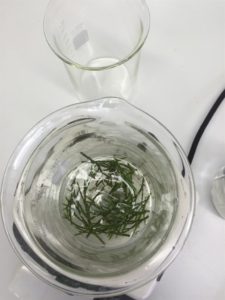
25. Step 6 all the alcohol must be rinsed off. Any residue will penetrate plant cells and kill them.
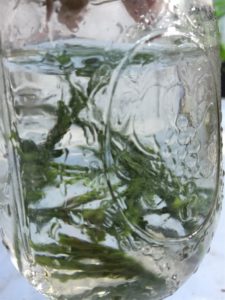
24. Step 5 one last disinfectant for 10-15 seconds in 70% alcohol.

26. Now, let’s do tissue culture.
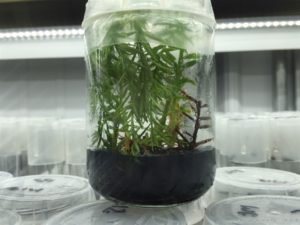
27. Tissue culture generally means pieces of a plant, intact pieces or branch tips.
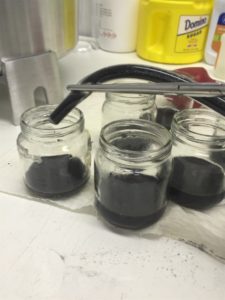
28. The media used for tissue culture has just the minimum amount of growth regulator to stimulate roots with pH set at 5.7. The black you see is activated carbon that is added to absorb waste metabolites and it also provides darkness as a stimulant for root initiation.
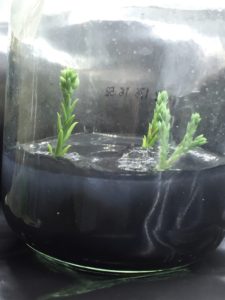
29. One of the many benefits of tissue culture is that these plants are sterile. They are certified pathogen-free and can be shipped globally.
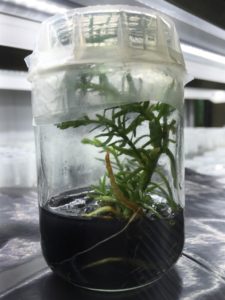
30. The small pieces of tissue grow until they start pushing the caps from the inside.
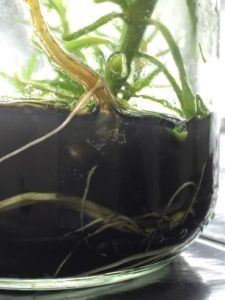
31. Awesome! Reminder: scientific experts said this was impossible.
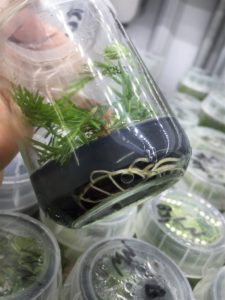
32. Take a hard look at this image for a few moments to really absorb this result. The little tree in there, from a genetic standpoint, is over 3000 years old. That’s truly amazing!

33. Once the plantlets are in their culture vessels they are put under special spectrum lighting.

34. In the frame of this photo are approximately 400 jars, each with 3-5 plantlets.
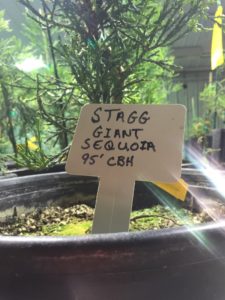
35. Here is evidence of the real power of these tissue culture methods: existing trees in the Archangel collection.
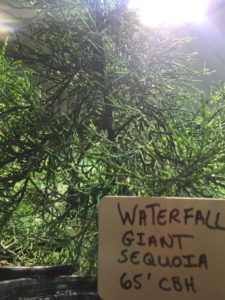
36. These trees are growing in the room adjacent to the tissue culture lab.

37. Thank you, Jim Clark, Archangel volunteer extraordinaire, for your unceasing efforts and marvelous photos.
In the next post, Planting Archangel Trees, you will see where some of the Archangel cloned trees have been planted.

Somehow I missed the link for ‘following’ your blog, Philip. So just now I’ve read through the whole thing, and what a trip!! It’s a three-fer: travel, trees, and science. Thank you for sharing all this with us!
It’s fascinating to see how the cuttings become trees! So cool!
I just now have had a chance to read over all this material. It’s such a wonderful project. I’m so thrilled that you are taking part in and will keep us informed. Your Uncle Ernie would be right there with you! He loved trees and science – what a combination… And I’m proud that the Archangel headquarters is in Michigan, close to the cabin… Thanks Philip!! Barb
Fantastic blog, Phillip! The Archangel project is fascinating and makes me hopeful. I would love to know how these trees do in their new homes.
How did giant redwood in step 4 turned into coastal redwood in step 5???
The tree being cloned in these photos is a giant sequoia (Sequoiadendron giganteum), not the coast redwood (Sequoia sempervirens).
We are tissue culturing Sequoia sempervirens from the South Carolina’s champion Coastal Redwood growing in Abbeville, SC. We have many shoots ready for rooting, and have used the recommended rooting medium amended with activated charcoal from Plants from Test Tubes by Lydiane Kyte et al page 217-18. The shoots in this medium for over two months have no signs of roots. Would like to know what formula you suggest for rooting redwood.
Thanks.
Can you be more specific about the type of disinfectant used to wash the tips, the strength of the hydrogen peroxide wash, and the ‘sanitizing solution’ and ‘biological detergent’? Any brand names, or chemical specifications, would be enormously helpful.
There are many other species that need to be cloned, and sharing the information would accelerate the saving of many other trees!
Thank you, and thanks for the inspiring work.
What is the hormone concentration used to propagate root growth? I live in the 94028 code where redwoods grow and have been attempting to root small cuttings with some difficulty. Thank you.
Is it possible to purchase some trees for planting in East Tennessee.
Are rules that must be followed for planting in rural Tennessee?
Coast redwood and giant sequoia trees and seeds can actually be purchased on Amazon at this link: https://www.amazon.com/s?k=redwood+tree&i=lawngarden&ref=nb_sb_noss_1.
My guess is that giant sequoia would have a better chance of survival in Tennessee than coast redwood.
Thank you very much for the info on how to propagate Redwoods and Seqoia sempervirens in particular. I sort of remember seeing the Coastal Redwoods, circa 1965, when I was only 3 years old while camping with my family in northern California… and how my dad looked sort of like “a silly, little Ant” standing next to a Coastal Redwood! As my mom & dad and six elder siblings and I traveled in our station wagon, we often sang the song “HIGH HOPES,” JFK’S campaign theme song…which went something like, “Once there was a silly, old Ant, who thought he could move a Rubber Tree Plant and EVERYONE KNOWS AN ANT CAN’T MOVE A RUBBER TREE PLANT… BUT HE HAD HIGH HOPES!” Tee-hee–heee… How silly! At the time, as an Electrical Engineer, specializing in telecommunications for the NASA Apollo Project, my dad often said, “NOTHING IS IMPOSSIBLE!” Given Moore’s Law, nothing is impossible. Where there is a will, there is a way. Is Planet Earth and Humanity doomed? Not if we put our noggins together and work together to ensure Earth’s environment is preserved.
I find all of this so exciting, you’ve really given me hope for our future. Thank you so very much for your fantastic contributions!